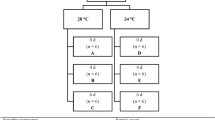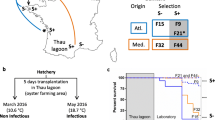Abstract
Studies of invertebrates have shown that the internal environment of crustaceans is not always sterile in normal conditions, and in many species, it can be populated by microorganisms even in the absence of any visible pathological processes in the body. This observation raises the question of whether genetically modified indigenous hemolymph microorganisms can be used for biotechnological purposes inside the crustacean either as local producers of some compounds or as sensors to physiological parameters. In this study, we tested the ability of the bacteria isolated from the hemolymph of the amphipod Eulimnogammarus verrucosus to hide from the cellular immune response of the host as the most important feature for their potential long-term application in vivo. 16S rDNA amplicon sequencing revealed five common bacterial genera in all analyzed samples of the amphipod hemolymph, among which Pseudomonas is most easily subjected to genome modification and, thus, the most prospective for biotechnological application. Cultivation of Pseudomonas gave us a number of strains undoubtedly derived from the amphipod hemolymph, and one of them (belonging to the Pseudomonas fluorescens group) was chosen for further tests. The primary culture of amphipod hemocytes was used to analyze the immunogenicity of the strain and showed a pronounced reaction of the immune cells to a high amount of the bacteria within six hours. This result indicates that modulation of cellular immune response to metabolically active bacterial cells is not mandatory for the survival and wide distribution of these microorganisms in the hemolymph of numerous amphipod individuals.



Similar content being viewed by others
References
Balabanova L, Averianova L, Marchenok M, Son O, Tekutyeva L (2021) Microbial and genetic resources for cobalamin (vitamin B12) biosynthesis: from ecosystems to industrial biotechnology. Int J Mol Sci 22:4522
Bel’kova NL, Parfenova VV, Kostornova TY, Denisova LY, Zaichikov EF (2003) Microbial biodiversity in the water of Lake Baikal. Microbiology 72:203–213
Bojko J, Burgess AL, Baker AG, Orr CH (2020) Invasive non-native crustacean symbionts: diversity and impact. J Invertebr Pathol. https://doi.org/10.1016/j.jip.2020.107482
Bojko J, Dunn AM, Stebbing PD, van Aerle R, Bacela-Spychalska K, Bean TP, Urrutia A, Stentiford GD (2018) ‘Candidatus Aquirickettsiella gammari’ (Gammaproteobacteria: Legionellales: Coxiellaceae): a bacterial pathogen of the freshwater crustacean Gammarus fossarum (Malacostraca: Amphipoda). J Invert Pathol 156:41–53
Bojko J, Ovcharenko M (2019) Pathogens and other symbionts of the Amphipoda: taxonomic diversity and pathological significance. Dis Aquat Org 136:3–36
Chattopadhyay P, Banerjee G, Mukherjee S (2017) Recent trends of modern bacterial insecticides for pest control practice in integrated crop management system. Biotech 7:60
Cornet S, Biard C, Moret Y (2009) Variation in immune defense among populations of Gammarus pulex (Crustacea: Amphipoda). Oecologia 159:257–269
Desriac F, Le Chevalier P, Brillet B, Leguerinel I, Thuillier B, Paillard C, Fleury Y (2014) Exploring the hologenome concept in marine bivalvia: haemolymph microbiota as a pertinent source of probiotics for aquaculture. FEMS Microbiol Lett 350:107–116
Dimova M, Madyarova E, Gurkov A, Drozdova P, Lubyaga Y, Kondrateva E, Timofeyev M (2018) Genetic diversity of Microsporidia in the circulatory system of endemic amphipods from different locations and depths of ancient Lake Baikal. PeerJ. https://doi.org/10.7717/peerj.5329
Duval D, Galinier R, Mouahid G, Toulza E, Allienne JF, Portela J, Gourbal B (2015) A novel bacterial pathogen of Biomphalaria glabrata: a potential weapon for schistosomiasis control? PLoS Negl Trop Dis. https://doi.org/10.1371/journal.pntd.0003489
Ejeian F, Etedali P, Mansouri-Tehrani HA, Soozanipour A, Low ZX, Asadnia M, Razmjou A (2018) Biosensors for wastewater monitoring: a review. Biosens Bioelectron 118:66–79
Gurkov A, Borvinskaya E, Shchapova E, Timofeyev M (2018) Restraining small decapods and amphipods for in vivo laboratory studies. Crustaceana 91:517–525
Gurkov A, Rivarola-Duarte L, Bedulina D, Casas IF, Michael H, Drozdova P, Nazarova A, Govorukhina E, Timofeyev M, Stadler P, Luckenbach T (2019) Indication of ongoing amphipod speciation in Lake Baikal by genetic structures within endemic species. BMC Evol Biol 19:138
Haushalter RW, Groff D, Deutsch S, The L, Chavkin TA, Brunner SF, Keasling JD (2015) Development of an orthogonal fatty acid biosynthesis system in E. coli for oleochemical production. Metab Eng 30:1–6
Jakob L, Axenov-Gribanov D, Gurkov A, Ginzburg M, Bedulina D, Timofeyev M, Luckenbach T, Lucassen M, Sartoris F, Pörtner H (2016) Lake Baikal amphipods under climate change: thermal constraints and ecological consequences. Ecosphere. https://doi.org/10.1002/ecs2.1308
Li H (2013) Aligning sequence reads, clone sequences and assembly contigs with BWA-MEM. arXiv preprint arXiv: 1303.3997
Maksimov IV, Veselova SV, Nuzhnaya TV, Sarvarova ER, Khairullin RM (2015) Plant growth-promoting bacteria in regulation of plant resistance to stress factors. Russ J Plant Physiol 62:715–726
Mardal M, Bischoff M, Ibáñez M, Ruffing U, Hernández F, Meyer MR (2017) Microbial biotransformation of five pyrrolidinophenone-type psychoactive substances in wastewater and a wastewater isolated Pseudomonas putida strain. Drug Test Anal 9:1522–1536
Mastore M, Arizza V, Manachini B, Brivio MF (2015) Modulation of immune responses of Rhynchophorus ferrugineus (Insecta: Coleoptera) induced by the entomopathogenic nematode Steinernema carpocapsae (Nematoda: Rhabditida). Insect Sci 22:748–760
Murali A, Bhargava A, Wright ES (2018) IDTAXA: a novel approach for accurate taxonomic classification of microbiome sequences. Microbiome 6:1–14
Newton RJ, Huse SM, Morrison HG, Peake CS, Sogin ML, McLellan SL (2013) Shifts in the microbial community composition of Gulf Coast beaches following beach oiling. PLoS One. https://doi.org/10.1371/journal.pone.0074265
Nikolaidis M, Mossialos D, Oliver SG, Amoutzias GD (2020) Comparative analysis of the core proteomes among the Pseudomonas major evolutionary groups reveals species-specific adaptations for Pseudomonas aeruginosa and Pseudomonas chlororaphis. Diversity 12:289
Okonechnikov K, Golosova O, Fursov M, Ugene Team (2012) Unipro UGENE: a unified bioinformatics toolkit. Bioinformatics 28:1166–1167
Parks DH, Chuvochina M, Waite DW, Rinke C, Skarshewski A, Chaumeil PA, Hugenholtz P (2018) A standardized bacterial taxonomy based on genome phylogeny substantially revises the tree of life. Nat Biotechnol 36:996–1004
Robach MC (1978) Effect of potassium sorbate on the growth of Pseudomonas fluorescens. J Food Sci 43:1886–1887
Schmitt P, Rosa RD, Duperthuy M, de Lorgeril J, Bachère E, Destoumieux-Garzón D (2012) The antimicrobial defense of the Pacific oyster, Crassostrea gigas. How diversity may compensate for scarcity in the regulation of resident/pathogenic microflora. Front Microbiol 3:160
Shchapova E, Nazarova A, Gurkov A, Borvinskaya E, Rzhechitskiy Y, Dmitriev I, Meglinski I, Timofeyev M (2019) Application of PEG-covered non-biodegradable polyelectrolyte microcapsules in the crustacean circulatory system on the example of the amphipod Eulimnogammarus verrucosus. Polymers 11:1246
Singh K, Ainala SK, Kim Y, Park S (2019) A novel D (−)-lactic acid-inducible promoter regulated by the GntR-family protein D-LldR of Pseudomonas fluorescens. Synth Syst Biotechnol 4:157–164
Tindall BJ, Rosselló-Móra R, Busse HJ, Ludwig W, Kämpfer P (2010) Notes on the characterization of prokaryote strains for taxonomic purposes. Int J Syst Evol Microbiol 60:249–266
Wang XW, Wang JX (2015) Crustacean hemolymph microbiota: endemic, tightly controlled, and utilization expectable. Mol Immunol 68:404–411
Weisburg WG, Barns SM, Pelletier DA, Lane DJ (1991) 16S ribosomal DNA amplification for phylogenetic study. J Bacteriol 173:697–703
Wright ES, Yilmaz LS, Noguera DR (2012) DECIPHER, a search-based approach to chimera identification for 16S rRNA sequences. Appl Environ Microbiol 78:717–725
Zhang X, Sun Z, Zhang X, Zhang M, Li S (2018) Hemolymph microbiomes of three aquatic invertebrates as revealed by a new cell extraction method. Appl Environ Microbiol 84:e02824-e2917
Zhang X, Zhang M, Zheng H, Ye H, Zhang X, Li S (2020) Source of hemolymph microbiota and their roles in the immune system of mud crab. Dev Comp Immunol 102:103470
Acknowledgements
We acknowledge Dr. Denis Axenov-Gribanov and Evgenii Protasov for help and advice on microbiological issues, as well as Dr. Polina Drozdova for help in the preparation of the manuscript.
Funding
The study was supported primarily by the Russian Foundation for Basic Research (#19–34-90137) and additionally by the Ministry of Science and Higher Education of Russia (#FZZE‐2020‐0026). AN was financially supported by the program «Mikhail Lomonosov» of the German Academic Exchange Service (DAAD) and the Ministry of Science and Higher Education of Russia (application #2300–21).
Author information
Authors and Affiliations
Corresponding author
Ethics declarations
Ethics Approval
All experimental procedures with amphipods were conducted in accordance with the EU Directive 2010/63/EU for animal experiments and were approved by the Animal Subjects Research Committee of the Institute of Biology at Irkutsk State University.
Conflict of Interest
The authors declare no competing interests.
Additional information
Publisher's Note
Springer Nature remains neutral with regard to jurisdictional claims in published maps and institutional affiliations.
Supplementary Information
Below is the link to the electronic supplementary material.
10126_2021_10039_MOESM1_ESM.xlsx
Supplementary file1: Table S1. The full list of the strains isolated from hemolymph and chitin surface of E. verrucosus with data on MALDI-TOF MS identification (XLSX 48 KB)
Rights and permissions
About this article
Cite this article
Shchapova, E., Nazarova, A., Vasilyeva, U. et al. Cellular Immune Response of an Endemic Lake Baikal Amphipod to Indigenous Pseudomonas sp. Mar Biotechnol 23, 463–471 (2021). https://doi.org/10.1007/s10126-021-10039-2
Received:
Accepted:
Published:
Issue Date:
DOI: https://doi.org/10.1007/s10126-021-10039-2




